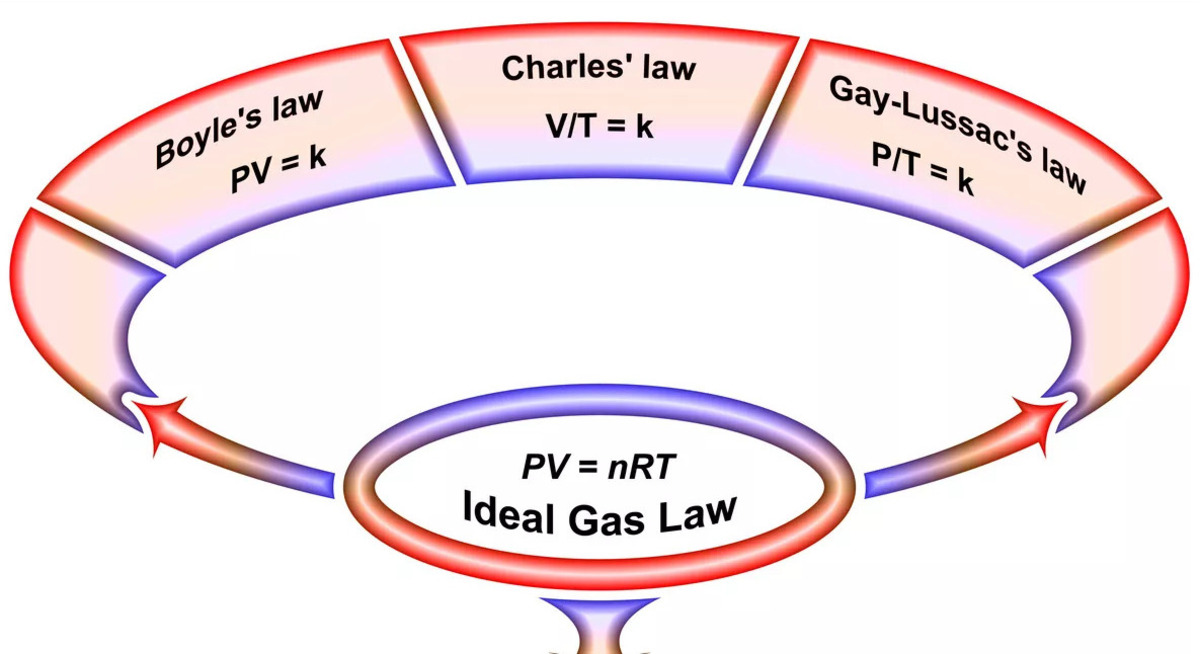
The study of gas laws is a fundamental aspect of physics that explores the behavior of gases under different conditions. From everyday experiences like inflating a balloon to advanced scientific applications such as understanding the properties of the Earth’s atmosphere, gas laws play a crucial role in our understanding of the physical world.
In this article, we will delve into the fascinating realm of gas laws and uncover some extraordinary facts that will not only enhance your knowledge but also spark your curiosity. From the relationship between temperature and pressure to the principles behind Boyle’s Law and Charles’ Law, we will explore the key concepts that govern the behavior of gases. So, buckle up and get ready for a journey into the intriguing world of gas laws!
Key Takeaways:
- Gas laws, like Boyle’s and Charles’s laws, help us understand how gases behave when pressure, volume, temperature, and the amount of gas change. These laws are like the rules that gases follow, and they have cool applications in scuba diving and hot air balloons.
- Gas laws, such as Avogadro’s and Dalton’s laws, show us how gases interact and behave in different conditions. They help scientists and engineers understand things like gas exchange in our lungs and how different gases diffuse and effuse.
The Relationship Between Pressure and Volume – Boyle’s Law
One of the fundamental gas laws is Boyle’s Law, which states that the pressure of a gas is inversely proportional to its volume, provided that the temperature remains constant. This means that as the volume of a gas decreases, its pressure increases, and vice versa. It was named after Robert Boyle, an Irish physicist, who discovered this relationship in the 17th century. Boyle’s Law helps us understand the principles behind various practical applications, such as the operation of the scuba diving regulator.
**Charles’s Law – The Relationship Between Temperature and Volume**
The Relationship Between Temperature and Volume – Charles’s Law
Charles’s Law establishes the relationship between the volume of a gas and its temperature. It states that, at a constant pressure, the volume of a gas is directly proportional to its temperature in Kelvin. Simply put, as the temperature of a gas increases, its volume also increases, and vice versa. This law, named after Jacques Charles, a French physicist, is crucial in understanding phenomena such as the expansion of hot air balloons and the operation of internal combustion engines.
**Avogadro’s Law – The Relationship Between Volume and Amount of Gas**
The Relationship Between Volume and Amount of Gas – Avogadro’s Law
Avogadro’s Law states that, at a constant temperature and pressure, equal volumes of gases contain an equal number of molecules. This principle is based on the concept of the mole, which represents a specific number of particles. According to Avogadro’s Law, if the number of moles of gas is doubled while keeping other conditions constant, the volume of the gas will also double. Avogadro’s Law has significant implications in various scientific fields, such as calculating the molar volume of gases.
**The Ideal Gas Law – A Unified Equation**
The Ideal Gas Law – A Unified Equation
The Ideal Gas Law combines Boyle’s Law, Charles’s Law, and Avogadro’s Law into a single equation. It states that the product of pressure, volume, and the number of moles of gas is proportional to the absolute temperature. The equation can be expressed as PV = nRT, where P represents pressure, V represents volume, n represents the number of moles of gas, R is the ideal gas constant, and T denotes the temperature in Kelvin. The Ideal Gas Law provides a comprehensive understanding of the behavior of gases under varying conditions.
**Dalton’s Law of Partial Pressures**
Dalton’s Law of Partial Pressures
Dalton’s Law states that the total pressure exerted by a mixture of non-reacting gases is equal to the sum of the partial pressures of each gas. In simple terms, the total pressure in a gas mixture is the sum of the pressures that each gas would exert if it occupied the container alone. This law is crucial in various applications, such as understanding the process of gas exchange in the lungs and calculating the composition of the Earth’s atmosphere.
**Graham’s Law of Effusion – The Rate of Gas Diffusion**
The Rate of Gas Diffusion – Graham’s Law of Effusion
Graham’s Law of Effusion states that the rate at which a gas diffuses or effuses is inversely proportional to the square root of its molar mass. In simpler terms, lighter gases diffuse or effuse faster compared to heavier gases. This principle is essential in various applications, such as understanding the behavior of gases in chemical reactions and designing efficient gas separation processes.
**Boyle-Mariotte Law – The Behavior of Gases Under Changing Pressure and Temperature**
The Behavior of Gases Under Changing Pressure and Temperature – Boyle-Mariotte Law
The Boyle-Mariotte Law states that for a fixed amount of gas at a constant temperature, the pressure and volume are inversely proportional to each other. This means that as the pressure of a gas increases, its volume decreases, and vice versa. This law is vital in studying the behavior of gases in closed systems and analyzing the effects of pressure changes on gas properties.
**Gay-Lussac’s Law – The Relationship Between Pressure and Temperature**
The Relationship Between Pressure and Temperature – Gay-Lussac’s Law
Gay-Lussac’s Law establishes the relationship between the pressure and temperature of a gas, provided that the volume remains constant. It states that the pressure of a gas is directly proportional to its temperature, in Kelvin, when the volume is held constant. This law is crucial in various applications, such as understanding the behavior of gases in combustion engines and analyzing the impact of temperature changes on gas pressure.
Conclusion
Gas laws are fundamental principles in the field of physics that describe the behavior of gases. In this article, we have explored some extraordinary facts about gas laws. From the relationship between pressure and volume to the effect of temperature on gas particles, these laws provide crucial insights into the nature of gases.One remarkable fact about gas laws is that they are universally applicable. Whether we are studying the behavior of gases on Earth or in outer space, the same principles hold true. This universality highlights the elegance and accuracy of these laws.Moreover, gas laws have practical applications in various fields. They help in understanding and predicting the behavior of gases in industrial processes, such as the compression and expansion of gas in engines. Gas laws also play a vital role in the field of meteorology, where they help in predicting weather patterns and understanding atmospheric conditions.In summary, gas laws are fascinating and powerful tools that offer profound insights into the behavior of gases. Understanding these laws can unlock a deeper understanding of the physical world around us.
FAQs
1. What are the fundamental gas laws?
The fundamental gas laws include Boyle’s law, Charles’s law, and Avogadro’s law. Boyle’s law describes the relationship between pressure and volume, Charles’s law relates temperature and volume, and Avogadro’s law connects volume and the number of gas particles.
2. How are gas laws applied in everyday life?
Gas laws are applied in various everyday life scenarios. For example, they explain why a balloon expands when heated, why a scuba diver needs to regulate their breathing at different depths, and why a spray canister cools down when the propellant is released.
3. Can gas laws be applied to all types of gases?
Yes, gas laws are applicable to all types of gases, provided the conditions are within the ideal gas law assumptions. However, real gases deviate slightly from ideal behavior at high pressures and low temperatures.
4. How do gas laws contribute to the study of weather?
Gas laws are crucial in meteorology as they help in understanding the behavior of gases in the atmosphere. They assist in predicting weather changes, studying atmospheric pressure systems, and explaining the movement of air masses.
5. What is the significance of gas laws in industrial processes?
Gas laws are essential in industrial processes such as refrigeration, compression, and combustion engines. They provide insights into gas behavior, helping engineers design efficient systems and understand how gases interact under different conditions.
Gas laws shape our understanding of the physical world, but there's still more to explore. Mindblowing facts about gas laws await your discovery, offering a deeper appreciation for these fundamental principles. Fascinating aspects of gas law remain hidden, ready to be uncovered by curious minds. Extraordinary facts about ideal gas law will change how you perceive the behavior of gases under various conditions.
Was this page helpful?
Our commitment to delivering trustworthy and engaging content is at the heart of what we do. Each fact on our site is contributed by real users like you, bringing a wealth of diverse insights and information. To ensure the highest standards of accuracy and reliability, our dedicated editors meticulously review each submission. This process guarantees that the facts we share are not only fascinating but also credible. Trust in our commitment to quality and authenticity as you explore and learn with us.


